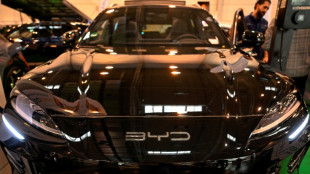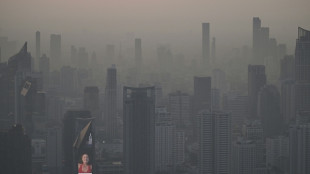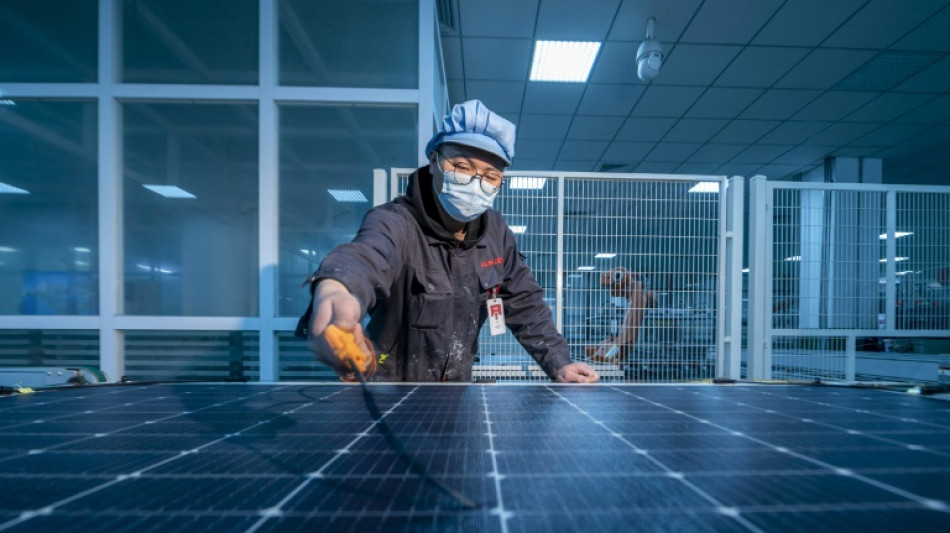
-
 Turkey steps up anti-IS raids, arresting 125 suspects
Turkey steps up anti-IS raids, arresting 125 suspects
-
Arteta says Arsenal reaping rewards for 'sacrifices and commitment'

-
 China says live-fire drills around Taiwan 'completed successfully'
China says live-fire drills around Taiwan 'completed successfully'
-
Nancy adamant he's still the man for Celtic job after Motherwell defeat

-
 Hoping for better year ahead, Gazans bid farewell to 'nightmare' of 2025
Hoping for better year ahead, Gazans bid farewell to 'nightmare' of 2025
-
Queen Camilla recalls fighting back against train attacker

-
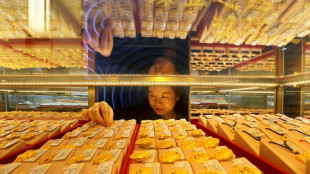 Stocks drop at end of record year for markets
Stocks drop at end of record year for markets
-
Amorim still 'really confident' about Man Utd potential despite Wolves draw

-
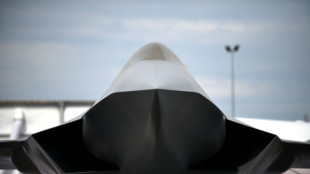 Berlin says decision postponed on European fighter jet
Berlin says decision postponed on European fighter jet
-
Iran prosecutor pledges 'decisive' response if protests destabilise country

-
 Emery defends failure to shake hands with Arteta after Villa loss to Arsenal
Emery defends failure to shake hands with Arteta after Villa loss to Arsenal
-
China says to impose extra 55% tariffs on some beef imports
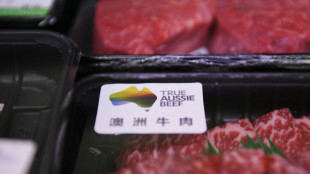
-
 Japanese women MPs want more seats, the porcelain kind
Japanese women MPs want more seats, the porcelain kind
-
Guinea junta chief Doumbouya elected president: election commission
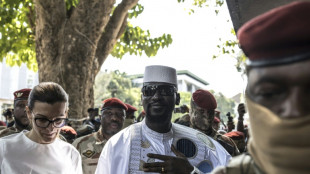
-
 Pistons pound Lakers as James marks 41st birthday with loss
Pistons pound Lakers as James marks 41st birthday with loss
-
Taiwan coastguard says Chinese ships 'withdrawing' after drills

-
 France's homeless wrap up to survive at freezing year's end
France's homeless wrap up to survive at freezing year's end
-
Leftist Mamdani to take over as New York mayor under Trump shadow

-
 French duo stripped of Sydney-Hobart race overall win
French duo stripped of Sydney-Hobart race overall win
-
Thailand releases 18 Cambodian soldiers held since July

-
 Tiny tech, big AI power: what are 2-nanometre chips?
Tiny tech, big AI power: what are 2-nanometre chips?
-
Libyans savour shared heritage at reopened national museum

-
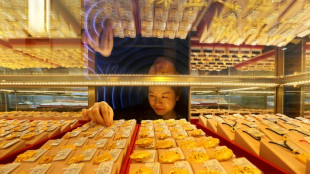 Asia markets mixed in final day of 2025 trading
Asia markets mixed in final day of 2025 trading
-
Global 'fragmentation' fuelling world's crises: UN refugee chief

-
 Difficult dance: Cambodian tradition under threat
Difficult dance: Cambodian tradition under threat
-
Regional temperature records broken across the world in 2025

-
 'Sincaraz' set to dominate as 2026 tennis season kicks off
'Sincaraz' set to dominate as 2026 tennis season kicks off
-
Bulgaria readies to adopt the euro, nearly 20 years after joining EU

-
 Trump v 'Obamacare': US health costs set to soar for millions in 2026
Trump v 'Obamacare': US health costs set to soar for millions in 2026
-
Isiah Whitlock Jr., 'The Wire' actor, dies at 71

-
 SoftBank lifts OpenAI stake to 11% with $41bln investment
SoftBank lifts OpenAI stake to 11% with $41bln investment
-
Bangladesh mourns ex-PM Khaleda Zia with state funeral
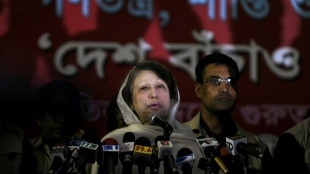
-
 TSMC says started mass production of 'most advanced' 2nm chips
TSMC says started mass production of 'most advanced' 2nm chips
-
Australian cricket great Damien Martyn 'in induced coma'

-
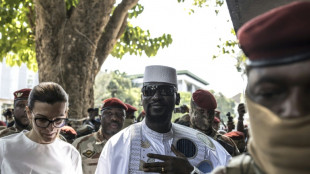 Guinea junta chief Doumboya elected president: election commission
Guinea junta chief Doumboya elected president: election commission
-
Laser Photonics Regains Nasdaq Compliance for Quarterly Filing Requirement

-
 CEO Letter to Aclara Shareholders: 2025 Accomplishments and 2026 Outlook
CEO Letter to Aclara Shareholders: 2025 Accomplishments and 2026 Outlook
-
Apex Provides Recap of 2025 Regional Exploration Drilling and Priority Follow Up Targets at the Cap Critical Minerals Project

-
 Guardian Metal Resources PLC Announces Total Voting Rights
Guardian Metal Resources PLC Announces Total Voting Rights
-
Caballero defends Maresca after Palmer substitution sparks jeers

-
 Depleted Man Utd 'lack quality', says Amorim
Depleted Man Utd 'lack quality', says Amorim
-
'We know what we want': Arteta eyes title after Arsenal thrash Villa

-
 Arsenal crush Villa to make statement in title race
Arsenal crush Villa to make statement in title race
-
Senegal top AFCON group ahead of DR Congo as Tanzania make history

-
 Maresca in the firing line as Chelsea stumble against Bournemouth
Maresca in the firing line as Chelsea stumble against Bournemouth
-
Senegal top AFCON group, DR Congo to face Algeria in last 16

-
 Norway's Magnus Carlsen wins 20th world chess title
Norway's Magnus Carlsen wins 20th world chess title
-
Patriots star Diggs facing assault charges: reports

-
 Journalist Tatiana Schlossberg, granddaughter of JFK, dies at 35
Journalist Tatiana Schlossberg, granddaughter of JFK, dies at 35
-
Rio receives Guinness record for biggest New Year's bash


China's solar goes from supremacy to oversupply
Strong state support and huge private investment have made China's solar industry a global powerhouse, but it faces new headwinds, from punitive tariffs abroad to a brutal price war at home.
Officials meeting in Baku next month for the COP29 summit hope to agree on new finance targets to help developing countries respond to climate change, including ditching fossil fuels.
Last year, countries agreed to triple global installed renewable energy capacity by 2030.
China is installing almost twice as much solar and wind power as every other country combined.
And it dominates the market.
It makes eight out of every 10 solar panels and controls 80 percent of every stage of the manufacturing process.
It is also home to the world's top 10 suppliers of solar panel manufacturing equipment, and its related exports hit a record $49 billion last year, according to Wood Mackenzie.
That supremacy is not accidental: Chinese state support has been key, analysts say.
Beijing invested over $50 billion in new solar supply capacity from 2011 to 2022, according to the International Energy Agency.
The industry has also benefited from access to cheap raw materials, readily available capital from state-owned banks, and huge engineering manpower.
"Chinese producers were ahead of everyone else on cost," said Lauri Myllyvirta, co-founder of the Centre for Research on Energy and Clean Air, a climate think tank.
"That meant new investment takes place in China, because that's where it's most competitive," he told AFP.
The focus has driven a "steep learning curve... both in solar cell technology and manufacturing know-how", added Johannes Bernreuter, a longtime solar industry analyst.
That in turn has created "an efficient industry ecosystem", he said.
- 'Overcapacity'-
As countries around the world race to convert their power systems, China's solar supremacy has become a growing concern.
The United States and other Western countries have accused Beijing of deliberate "overcapacity" and flooding global markets with cut-price solar exports intended to undercut competition.
Washington has doubled tariffs on Chinese panels to 50 percent, part of a broader package targeting $18 billion worth of Chinese imports in strategic sectors including electric vehicles, batteries, critical minerals and medical products.
The European Union is also probing Chinese-owned solar panel manufacturers for allegedly receiving unfair subsidies.
Most US solar panel imports now come from Southeast Asia, but Washington says Chinese manufacturers have relocated operations there to circumvent barriers.
China also accounts for almost all of Europe's imports of solar panels from outside the bloc.
That means many markets will struggle to catch up "with two decades of very forceful and very successful industrial policy in China", said Myllyvirta.
China's solar industry faces its own struggles though, beyond trade barriers in the West.
The sector's supersonic expansion has overleveraged the domestic industry, overloaded China's grid and sparked a brutal price war, experts say.
Industry leaders have reportedly warned of an "ice age" and urged government intervention to stem slumping prices, but there has been little sign of relief.
This year saw a wave of bankruptcies, and new solar projects fell by over 75 percent in the first half of 2024, an industry group said in July.
- 'Lots of companies will fail' -
The price wars, which are so fierce that solar export earnings fell last year despite volumes hitting a new high, are like a "snake eating its own tail", warned analyst David Fishman.
Companies get stuck "in this circle of competition where whoever is able to endure the pain for longest comes out as the victor," said Fishman, a senior manager at the Lantau Group specialising in China's power sector.
"Lots of companies will fail along the way."
And while the manufacturing glut has helped China hit a wind and solar installation target nearly six years ahead of schedule, the country's grid is struggling to keep up.
Increasingly, renewable supply is being blocked to prevent the grid from becoming overwhelmed, a process known as curtailment.
Solar curtailment rose four percent in the first quarter of 2024 from a year earlier, according to Fitch Ratings.
Authorities will soon be forced to "stop approving new projects or allowing projects to connect to the grid if it means curtailment rates are at risk of going higher", Fishman said.
"They've got to build," he added. "They have to catch up."
Blocked in the West and running out of track at home, China's solar is seeking new markets, and this year, Europe was overtaken by Asia as the biggest export market for solar products, according to an industry body.
Exports to Africa also soared 187 percent year-on-year in 2023, though the continent still buys a small fraction compared to Europe, according to energy think tank Ember.
The industry is now in a "restructuring and shakeout phase", said Bernreuter.
After that, "the Chinese solar industry will march on with unperturbed pace and a more global manufacturing footprint".
S.Gregor--AMWN
